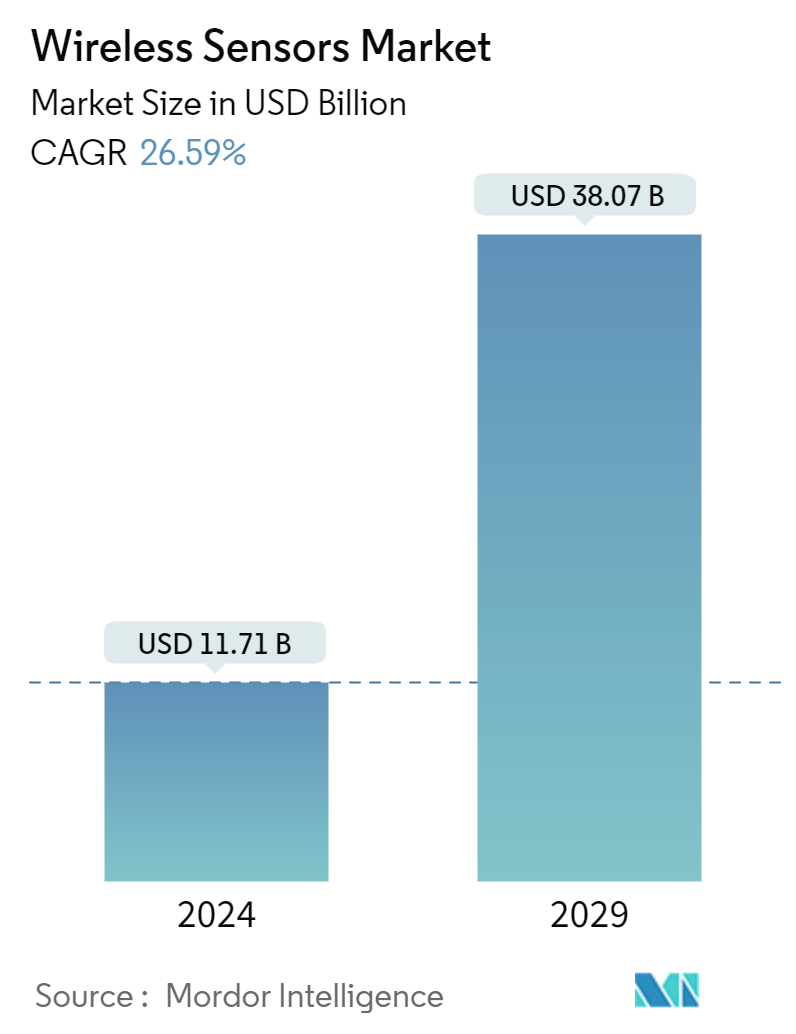Market Size of Wireless Sensors Industry

| Study Period | 2019 - 2029 |
| Market Size (2024) | USD 11.71 Billion |
| Market Size (2029) | USD 38.07 Billion |
| CAGR (2024 - 2029) | 26.59 % |
| Fastest Growing Market | Asia Pacific |
| Largest Market | North America |
Major Players
*Disclaimer: Major Players sorted in no particular order |
Wireless Sensors Market Analysis
The Wireless Sensors Market size is estimated at USD 11.71 billion in 2024, and is expected to reach USD 38.07 billion by 2029, growing at a CAGR of 26.59% during the forecast period (2024-2029).
Wireless sensors offer several advantages, such as accuracy and reliability, with the help of various innovative technologies, such as RFID and Bluetooth, and the potential to make electronic devices easy to integrate. As a result, they gained significant traction in the past few years. These sensors are primarily used in factory settings for data monitoring production flow. These also find applications in Automotive, defense, building automation, and other industries, like materials handling and food and beverage. Due to the increasing quest for new energy sources, government regulations, renewable energy development, and rapid technological advancements, the wireless sensors market is propelling.
- Wireless sensors are considered a vital component in smart grids for remote monitoring of power lines and transformers. They are present in service to monitor line temperature and weather conditions. Industrial automation and demand for miniaturized consumer devices across regions, such as wearables and IoT - connected devices, are among the significant factors driving the wireless sensors market.
- Due to the increased government regulation for the increased use of the sensor for safety, the demand for wireless sensors is growing. For instance, the areas with challenging environmental conditions, such as Oil rigs, Boilers, etc., present high pressure, high temperature, etc. Wireless sensors make it easy to control and monitor the facility from a safe distance.
- The industry 4.0 revolution, in which machines are becoming brighter and more intuitive, is increasing the need for wireless sensors' industrial applications. The new devices are designed to be more efficient, safe, and flexible, with the ability to monitor their performance, usage, and failure autonomously. These applications, therefore, spur the demand for highly- sensitive sensors.
- The rising adoption of IoT is another major factor driving the market's growth. This growth in IoT-connected devices is projected to fuel the demand for wireless sensors. Further, transforming the development of smart homes and buildings, smart cities, and intelligent factories demands wireless sensors, owing to the small form factor, high precision, low power consumption, and ability to control ambient parameters.
- These sensors have reduced installation costs and minimal disruption to the workforce and interiors; therefore, installing wireless sensor systems requires no wiring or structural building changes. Many companies are investing in wireless technologies, which are cost-effective, safe as well as convenient.
- For instance, Monnit Corporation recently announced its ALTA Soil Moisture Sensor's availability to meet the AgriTech market's demands. The innovative Soil Moisture Sensor assists farmers, commercial growers, and greenhouse managers in easily connecting their precision irrigation operations to the Internet of Things (IoT). The defense sector is embracing wireless sensor technology, as these sensors can monitor their premises, identify suspicious activity, and track valuable assets.
- However, the demand for high-performance, cost-efficient, and reliable sensors has increased, leading to higher spending in R&D activities by market vendors. These technological advancements in nanotechnology and micro-technology are expected to propel the market growth of wireless sensors over the forecast period.
Wireless Sensors Industry Segmentation
Wireless sensors are measurement tools for monitoring and recording the physical conditions of the environment. They are equipped with transmitters that convert signals from process control instruments into a radio transmissions.
The wireless sensors market is segmented by type (pressure sensor, temperature sensor, chemical and gas sensor, position and proximity sensor), by end-user industry (automotive, healthcare, aerospace and defense, energy and power, food and beverage), and by geography. the market sizes and forecasts are provided in terms of value (USD) for all the above segments.
| By Type | |
| Pressure Sensors | |
| Temperature Sensors | |
| Chemical and Gas Sensors | |
| Position and Proximity Sensors | |
| Other Types of Sensors |
| By End-user Industry | |
| Automotive | |
| Healthcare | |
| Aerospace and Defense | |
| Energy and Power | |
| Food and Beverage | |
| Other End-user Industries |
| ***By Geography | |
| North America | |
| Europe | |
| Asia | |
| Australia and New Zealand |
Wireless Sensors Market Size Summary
The wireless sensors market is experiencing significant growth, driven by the increasing demand for accurate and reliable data monitoring across various industries. These sensors, utilizing technologies like RFID and Bluetooth, are becoming integral in sectors such as automotive, defense, building automation, and food and beverage. The push towards Industry 4.0 and the rise of IoT-connected devices are further propelling the market, as these sensors offer the precision and efficiency needed for smart grids, industrial automation, and smart city developments. The market is also benefiting from advancements in nanotechnology and micro-technology, which enhance sensor performance and reduce costs, making them more accessible for widespread use.
The Asia Pacific region, particularly China and Japan, plays a crucial role in the wireless sensors market due to its robust electronics manufacturing and automotive industries. The region's focus on connected cars and healthcare innovations is expected to drive further adoption of wireless sensors. Key players in the market, such as Honeywell, Siemens, and Emerson, are investing heavily in research and development to maintain their competitive edge. These companies are also engaging in strategic partnerships and collaborations to expand their market presence and enhance their product offerings. As the demand for energy-efficient and cost-effective solutions continues to rise, wireless sensors are poised to become a cornerstone in various industrial and consumer applications.
Wireless Sensors Market Size - Table of Contents
-
1. MARKET INSIGHTS
-
1.1 Market Overview
-
1.2 Industry Attractiveness - Porter's Five Forces Analysis
-
1.2.1 Bargaining Power of Suppliers
-
1.2.2 Bargaining Power of Consumers
-
1.2.3 Threat of New Entrants
-
1.2.4 Threat of Substitutes
-
1.2.5 Intensity of Competitive Rivalry
-
-
1.3 Impact of COVID-19 on the Wireless Sensors Market
-
-
2. MARKET SEGMENTATION
-
2.1 By Type
-
2.1.1 Pressure Sensors
-
2.1.2 Temperature Sensors
-
2.1.3 Chemical and Gas Sensors
-
2.1.4 Position and Proximity Sensors
-
2.1.5 Other Types of Sensors
-
-
2.2 By End-user Industry
-
2.2.1 Automotive
-
2.2.2 Healthcare
-
2.2.3 Aerospace and Defense
-
2.2.4 Energy and Power
-
2.2.5 Food and Beverage
-
2.2.6 Other End-user Industries
-
-
2.3 ***By Geography
-
2.3.1 North America
-
2.3.2 Europe
-
2.3.3 Asia
-
2.3.4 Australia and New Zealand
-
-
Wireless Sensors Market Size FAQs
How big is the Wireless Sensors Market?
The Wireless Sensors Market size is expected to reach USD 11.71 billion in 2024 and grow at a CAGR of 26.59% to reach USD 38.07 billion by 2029.
What is the current Wireless Sensors Market size?
In 2024, the Wireless Sensors Market size is expected to reach USD 11.71 billion.

